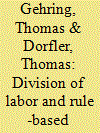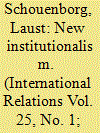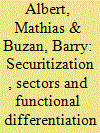|
|
|
Sort Order |
|
|
|
Items / Page
|
|
|
|
|
|
|
| Srl | Item |
| 1 |
ID:
125383


|
|
|
|
|
| Publication |
2013.
|
| Summary/Abstract |
Decisionmaking within the Security Council increasingly involves delegation to subsidiary bodies. Drawing on modern institutional theory, this article examines the effects of the emergent system of divided labor within the al-Qaeda/Taiwan sanction regime. The article first looks at the political economy of the process of listing individuals and private entities as sanctions targets. Second, it explores the distinct functions performed by the bodies of the sanctions regime; namely, the Security Council, the AQT Sanctions Committee, the Office of the Ombudsperson, and an expert body. Third, it analyzes the resulting incentive structures in three successive stage of regime development. The article concludes that the sanctions regime constitutes a surprisingly well-advanced model of how to commit even powerful states to rule based governance without depriving them of their capability to adopt political decision.
|
|
|
|
|
|
|
|
|
|
|
|
|
|
|
|
| 2 |
ID:
104035


|
|
|
|
|
| Publication |
2011.
|
| Summary/Abstract |
In this article I engage with the theoretical opening provided by Barry Buzan's From International to World Society? I present an argument for five functional categories, which should be able to encompass all the institutions identified by English School scholars throughout history. Their introduction should point the way towards a sounder analytical framework for the study of what Buzan believes should be the new subject of the discipline of International Relations (IR). This subject is defined as second-order societies, meaning societies 'where the members are not individual human beings, but durable collectivities of humans possessed of identities and actor qualities that are more than the sum of their parts', and where the content of these societies, and the key object of analysis, is primary institutions. The purpose of the five functional categories is to break down this 'social whole' and provide a set of lenses through which to potentially analyse international societies throughout history.
|
|
|
|
|
|
|
|
|
|
|
|
|
|
|
|
| 3 |
ID:
116341


|
|
|
|
|
| Publication |
2012.
|
| Summary/Abstract |
How does the way in which a group organizes change the lethality of the group's attacks? In this article, we argue that groups organized vertically as hierarchies are likely to conduct more lethal attacks. We build our argument around three advantages inherent to centralized structures: functional differentiation, clear command and control structures, and accountability. We argue that each of these characteristics positively impacts an organization's ability to deliver an effective lethal blow. To test our argument, we use a mixed method approach, drawing on empirical evidence and support from a time-series case study. Our large-N analysis examines the trends in more than 19,000 attacks. In this test we develop a novel proxy measure for hierarchy based on a group's bases of operation and non-violent activities. To complement the empirical work, we examine the history of Euskadi Ta Askatasuna (ETA), the Basque separatist group. Over several decades of violent operations, this group's structure has changed dramatically. We analyze how these shifts impacted ETA's ability to maximize the effectiveness and damage of their attacks. In both the case study and large-N analysis, the more hierarchically organized the group, the more easily the group can orchestrate lethal attacks.
|
|
|
|
|
|
|
|
|
|
|
|
|
|
|
|
| 4 |
ID:
109593


|
|
|
|
|
| Publication |
2011.
|
| Summary/Abstract |
So far, securitization analysis has proceeded on the basis of an assumption that there are sectoral differences between securitization dynamics. However, sectors in this context were primarily seen as analytical 'lenses', as complexity-reducing cuts through a complex social reality. In this article, we first reflect on the ontological status of 'sectors'. Do they represent functionally differentiated realms of world politics or world society, or do sectors and functional realms need to be separated from one another clearly? After giving a short introduction to the notion of 'functional differentiation' in international relations and briefly reflecting on the ontological/analytical distinction, we scrutinize the relation between sectors and functionally differentiated realms of society. Although sectors hang together with functional differentiation, much depends on the version of functional differentiation theory used. In the communication theoretical version, securitization would be firmly located within the political system. References to functionally specific sectors would then - contra Waltz - point not only towards functional differentiation between the political and other functionally defined realms of (international) society, but also towards ongoing functional differentiation within the (international) political system.
|
|
|
|
|
|
|
|
|
|
|
|
|
|
|
|
|
|
|
|
|